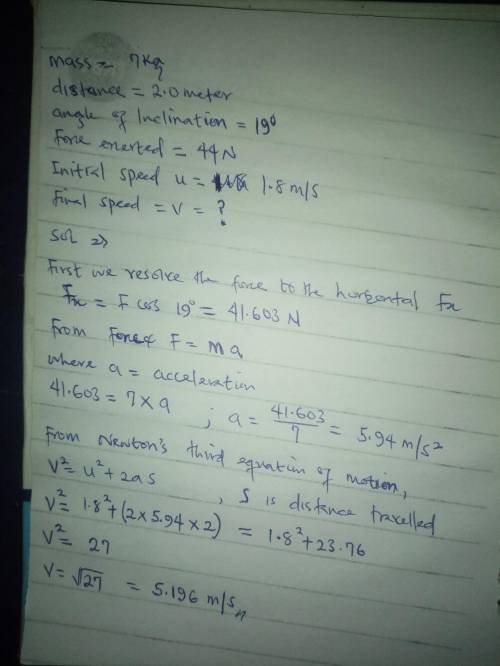Learning Goal:
To practice Problem-Solving Strategy 6.1 Work and Kinetic Energy.
...

Physics, 15.04.2020 23:31 DineroLaForeign
Learning Goal:
To practice Problem-Solving Strategy 6.1 Work and Kinetic Energy.
Your cat �Ms.� (mass 7.00kg ) is trying to make it to the top of a frictionless ramp 2.00m long and inclined 19.0? above the horizontal. Since the poor cat can�t get any traction on the ramp, you push her up the entire length of the ramp by exerting a constant 44.0N force parallel to the ramp. If Ms. is moving at 1.80m/s at the bottom of the ramp, what is her speed when she reaches the top of the incline?
A) What is the cat's speed v2 when she reaches the top of the incline?
B)This problem can also be done without the work�energy theorem.
Since the forces acting on the cat are constant, the cat is moving up the ramp with a constant acceleration. Therefore, if you know her acceleration, you can use the equations of motion for constant acceleration to find her final speed. Use Newton's 2nd law to find the magnitude a of the cat's acceleration
Express your answer in meters per second squared to three significant figures.

Answers: 2
Another question on Physics


Physics, 22.06.2019 01:10
Suppose that two tanks, 1 and 2, each with a large opening at the top, contain different liquids. a small hole is made in the side of each tank at the same depth 1.57 m below the liquid surface, but the hole in tank 2 has 2.49 times the cross-sectional area of the hole in tank 1. (a) what is the ratio ρ1/ρ2 of the densities of the liquids if the mass flow rate is the same for the two holes? (b) what is the ratio rv1/rv2 of the volume flow rates from the two tanks? (c) at one instant, the liquid in tank 1 is 14.9 cm above the hole. if the tanks are to have equal volume flow rates, what height above the hole must the liquid in tank 2 be just then?
Answers: 3

Physics, 22.06.2019 21:00
Acentrifuge in a medical laboratory rotates at an angular speed of 3,700 rev/min. when switched off, it rotates through 54.0 revolutions before coming to rest. find the constant angular acceleration (in rad/s2) of the centrifuge. your response is within 10% of the correct value. this may be due to roundoff error, or you could have a mistake in your calculation. carry out all intermediate results to at least four-digit accuracy to minimize roundoff error. rad/s2
Answers: 1

Physics, 23.06.2019 01:20
What is the state of matter with a specific volume but no definite shape
Answers: 1
You know the right answer?
Questions


Mathematics, 01.03.2021 01:10


Computers and Technology, 01.03.2021 01:10

Physics, 01.03.2021 01:10

Mathematics, 01.03.2021 01:10





Mathematics, 01.03.2021 01:10

English, 01.03.2021 01:10


Physics, 01.03.2021 01:10





Chemistry, 01.03.2021 01:10

Spanish, 01.03.2021 01:10




